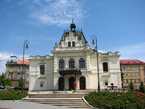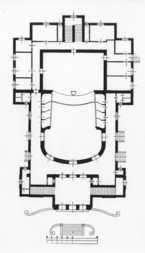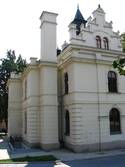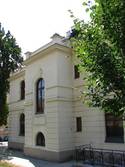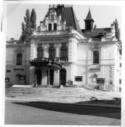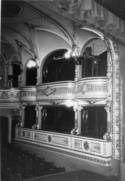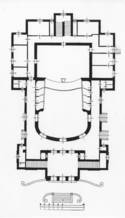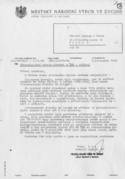Town Theatre Znojmo
Alexander Graf
alias Stadttheater in Znaim (1900 - 1918), South Moravia Theatre in Znojmo (1965 - 2000), City Theatre (1918 - 1965)nám. Republiky 20 | |
| show on the map | http://www.znojemskabeseda.cz/divadlo/ |
Important events
First permanent theatre stage came into existence by adaptation of former chapel of st. Bernard, which belonged to Poor Clare’s convent. The theatre was closed up due to completely inconvenient condition in 1892.
Several architects were invited to work out design for a new theatre building. Following architects were addressed: Rudolf Klotz, Ignaz Ungwer and atelier Fellner & Helmer, later, in 1895 also August Fessler, Franz Roth a Alexander Graf. Definitive decision was made in 1899, when design by Alexander Graf won.
Graf provided executing plans and designs in May, 1899. Construction work began the same year. Ceremonial opening took place on 29th September 1900, inaugural play was Zwei glückliche Tage by Franz Schöntan and Gustav Kadelburg.
Theatre building went through the most complex restoration after 1989. Restoration and reconstruction works began in 1992. Renovated theatre was ceremonially opened on 29. September 2000 on 100th anniversary by Blodek´s opera In fountain.
People
A co-worker of the atelier Fellner and Helmer. He employed the proven Renaissance-Baroque style as was usual in the atelier Fellner and Helmer in most of the small city theatres he built in various parts of the monarchy. By the other buildings, he did not take great delight in experimenting as the buildings have the form of the Italian or German Renaissance and are ornamented with Baroque motifs.
More theatresHistory
First permanent theatre stage emerged in Znojmo in former St. Bernard chapel, which belonged to the premises of Poor Clares convent. Necessary adaptation works were being carried out in 1782 – 1784. The theatre enjoyed wide popularity even despite insufficient technical facilities and primitive equipment, the productions were amply plenteously attended. Constitution of completely new theatre building had been considered since 1860s due to deteriorating structural and technical building state. The realization, respectively emergence of whichever detailed design, has never happened. Instead, the operation of existing institution was suspended by the end of 1891 due to completely inconvenient conditions. Theatre associations produced their plays only in provisional hall in the following years – in „Bürgervereinhaus“ ( present building of Česká spořitelna), eventually in garden hall of „U zlatého kříže“ (By Golden Cross) inn (today „U jasného kříže“, By Bright Cross). The spectators watched the pieces, played in Czech, in the hall of „U zlaté studně“ (By Golden Well), since 1880s, in ridotto hall of association house.
The city council commenced solving this dismal situation in 1892 – eleven-member committee was appointed to procure the emergence of new theatre building project and to bring this plan to realization. The first step was the selection of convenient locality. Renowned Viennese Firm Fellner & Helmer took over this task and submitted seven possible locations in the end. The most convenient one seemed to be the area in Dolní sady (Lower Gardens) (contemporary Střední park, Central Park, between Pontassievská Street and Komenského Square), eventually Salis’ Square( contemporary Republic Square). Several architects were summoned to submit the design of planned building – among them for instance Rudolf Klotz, Ignaz Ungwer or Firm Fellner & Helmer.
There was simultaneously emerging a design for reconstruction of existing building of „Bürgervereinhaus “,which inner spaces were meant for accommodating a completely new stage. The author of the reconstruction design was Viennese architect August Fessler. City administration declined this alternative in the end and applied again to selected builders and architects. They were called upon working-out and delivery of further new theatre building designs. Apart of previously engaged Rudolf Klotz, Ignaz Ungwer or Firm Fellner & Helmer, the selection was participated by August Fessler, Franz Roth and Alexander Graf as well.
The number of considered projects was reduced later on to designs by architect Roth, Graf and Firm Fellner & Helmer. A final decision was made in 1889, to the commissioner, the design by Alexander Graf seemed to be the most convenient. The area in upper part of Salis’ Square was selected from suggested possible plots. The architect delivered operational design already in the same year, subsequent construction works were proceeding at the high speed forward. Shell construction was finished in winter season, the interior adjustments occurred in the following year.
Ceremonial opening of the new building took place on 29th September 1900, inaugural night was introduced by play Zwei glückliche Tage by Franz Schöntan and Gustav Kadelburg.
The original theatre name Stadttheater in Znaim was replaced by Czech appellation Městské divadlo (City Theatre) after 1918. The stage carried the name South Moravia Theatre in Znojmo. The last change was made in 2000, when the original name Městské divadlo (City Theatre) returned.
The object is detached building in the upper part of Republic square. By designing, the architect proceeded from his older realization of Jubilee Theatre (Kaiserjubiläums-Stadttheater), transposed into more simple appearance in Znojmo. Graf had the exterior be made in Neo- Renaissance forms.
The construction is separated from adjacent surface communication by grass areas and strips, semicircle walkway with fountain in front of front facade part. Wide three-flight staircase and curved access ramp, passing closely by theatre entrance door, resume on it. In the width of front entry, the ramp is covered with metal canopy, supported by two cast-iron columns.
The centre of main five axial facade is emphasized by central, markedly projected, three axial bay. Its ground floor opens with triple of entrances with semicircular funicular arches, framed by profiled chambranles with central keystones in the form of mascarons. Pilasters, articulated by banded rustication, frame the storey of the bay, compound pilasters articulate the windows. Blind balustrade panels and scroll brackets carry parapets, chambranles of semi arched windows are topped with massive keystone with motive of mascaron on front surface. Stepped gable, which appearance is borrowed from the architects’ previous design of Viennese Jubilee Theatre, towers above the crowning cornice. The area behind the gable is topped by chisel roof with petty lantern mounted to it.
Shallow bays emphasize the central segment of wide boundary axes of entrance facade and resumed axes of side facades. Those are broken in ground floor of front flank by not large squared field, being used as an information board, and in the storey by segmentally arched window with keystone. These window openings are inserted into embedded rectangular frames with parapets, supported by couple of brackets and with triangular pediment in the top. Lateral facades of the theatre are broken by windows and portals with compound keystones in funicular arches; on sides flat bossage interrupt storey windows chambranles. Rectangular staircase casing, with semicircular window above the plinth and high segmentally vaulted in the mezzanine, is projected out of the rear facade. Window arrangement
Ventilating lantern with onion-domed protrudes on ridge from flat saddle roof above the auditorium. Fly tower part is topped by transversely disposed saddle roof, ventilating lantern with sharp pyramidal coping is embedded in it; tiered gables, broken by couple of window openings, are used on the sides.
The building ground floor is embellished by banded rustication, the corners are highlighted by stiffening. Low parapet, in the form of full mason belt, proceeds above the crowning cornice. It is alternated with short balustrade sector solely in the front facade.
Rigidness of exterior implementation of style is in contrast with decorativeness of Neo Rococo interior. Two opposite staircase flights proceed from entry vestibule to balcony and upper circle boxes. Its portals are made more ostentatious by couple of hermas and atlases, then cartouches in the top of semicircle chambranle. Vestibule walls are segmented by pilasters with motives of mascarons on the shafts and volute capitals with vegetal reliefs; the ceiling is decorated by centrally situated stuccowork. Everything is united in coloured combination of white and gold. The vestibule opens by triple of entries to the semicircular corridor, from where the spectator enters into the actual theatre hall. Rich stucco ornamentation, ceiling painting and distinguished gilding as well create pretentious representative space from the hall. For plays watching, the visitors can use the seats in the stalls and the balcony – this overarch the entire width of the room in slight arched recess, supported by couple of thin columns with palmette capitals – and in loges as well. These are located in two storeys by the stage, the central part is always duplicated. Stools are covered by red plush covering. The space is topped by flat vault with lunettes.
Decorative gilded stuccos, which has covered almost the whole surface of the hall, emerged due to cooperation of Viennese sculptor ateliers Fischer and Haselsteiner & Bock. They were implemented by portal mirror (vegetal motive around the entire circumference, central cartouche with motive of eagle- city emblem- above the lintel), on breastwork of boxes (motive of mirrors with central circle rosettes, vegetable strips in ground floor, cartouches in storey, strip of pipes), on lower side of storey boxes landing ( vegetal motive),on pillarets separating individual boxes ( motive of caulcole in the ground floor, projecting pilasters in storey, cartouches etc.) and on breastwork of balcony (motives of cartouches, vegetable strips by lower edge etc.).
Room ceiling is divided by stucco “ribs” into three transverse fields. The central division is dominated by oblong mirror with ceiling painting, which depicts cupids carrying flower garlands and cartouche with year 1900. The authors of the scenery are Viennese decorators Franz Schallud and K. Frank. The surface over the balcony is broken by circle ventilating shaft with richly decorated covering grid. Shaft was framed by stucco rocaille cartouche, from which thin gilded bars project radially. Chandelier is hanged from its centre. On the sides, lunettes divide balcony ceiling with inner surface covered by painting ( motive of vases and rocaille); sectors stem from pilasters with capitals in the form of mascarons, cartouches ornament them in the top and footing.
Schallud and Frank created the painted curtain with name „U pramene poezie (By the well of poetry“ (made in 1900). Iron, antifire curtain was covered by decorative painting imitating tapestry with geometric pattern.
Dressing rooms furniture was designed by atelier of Alexander Graf, original stage machinery was drafted by Viennese technician F.B. Bretschneider.
Theatre management proceeded to first stage adjustments already three years after ceremonial opening – architect enlarged the amount of seats due to huge public interest. The appearance of the auditorium ground floor segment was altered due to the same reason in 1909, another 26 seats were added sideways then. First major reconstruction was occurring in 1930s; orchestra pit was enlarged (towards under the stage floor), stage technology was being adjusted, electricity distribution was replaced. Original “perches” ( standing rooms) were replaced by new seats in 1940. The object underwent another thoroughgoing repair and modernization in 1945-1946 – especially its left side, considerably damaged by bombing in 1945. Negative impact on the appearance of the stage and interior form was caused by construction works in 1950s and 1960s, mainly carried out significantly insensitively (exchange of original hot-air heating for central heating, insertion of technician booth into the auditorium space, buffet adjustments, liquidation of sceneries storeroom in Republic Square etc.).
It has come to the more complex building renovation in post revolution era. The rearrangements were launched in 1992, new electric and water installation were laid down in the first phase, stage was repaired, original hot-air heating was partially renewed; roof and facade reconstruction followed six years later. The attention was concentrated on interiors since 1999 – stucco, gilding were being renovated etc. (the project was being carried out by Prague restoration firm TRADICE spol. s r.o.). Original Graf’s system of hot-air heating was renewed as well. Complete transformation of floors was carried out in ground floor, balcony, stage, proscenium, orchestra pit and storerooms. The walls acquired new wallpapers, authentic hangings in loges and cloak rooms were restored. By removal of glass door, foyer in first floor opened into the sides, towards side staircases with renewed stone banisters (with new lamp-posts). Bar occupied the foyer space, chandelier was installed, ceiling obtained stucco decoration. Brno architectural atelier HEXAGON has the credit for mentioned repairs, adjustments and innovations.
Regenerated theatre was ceremonially opened on the day of hundred anniversary of scene operation on 29th September 2000 by Vilém Blodek’s opera V studni ( In the well).
Employed sources and literature:
- Plánová dokumentace, AMZ - P/51, FO: 1-243.
- Hilmera, Jiří: Česká divadelní architektura; Praha 1999, s.68- 69.
- Stehlíková, Drahoslava & Šturc, Libor & Krejčí, Jaroslav: Zpráva o městském divadle ve Znojmě; Znojmo 2000.
- Šturc, Libor: Městské divadlo ve Znojmě 1900-2000; Znojmo 2000.
Tags: Neo-Baroque, Austria-Hungary, Neo-Renaissance, Fin de siècle, detached building, prestige building
Author: Kateřina Kohoutkova - Gabrhelíková
Kateřina Kohoutkova - Gabrhelíková:
Theatre of Bolek Polívka, City Theatre Brno, West Bohemia Theatre in Cheb, Spa Theatre Luhačovice, Theatre of Music Olomouc, Town Theatre Znojmo, Mahen Theatre Brno, Janáček Theatre, Reduta Theatre, Božena Němcová Theatre, Na Veveří Theatre, Architectural competition for the design of the Czech National Theatre in Brno, 1936-37, Centre for Experimental Theatre - Goose on a String Theatre, Architectural competition for the design of the Czech national Theatre in Brno, 1910-1913, Cinema the World, Culture House Ostrov, Municipal House of Culture Sokolov, Musical Theatre HodolanyTranslator: Jan Purkert
Jan Purkert:
Vienna State Opera, Theatre of Bolek Polívka, City Theatre of J.K. Tyl, Kolowrat Theatre, Theatre of Puppets Ostrava, Minor Theatre, Theatre on the Balustrade, Rokoko Theatre, Highland Theatre, South Bohemian Theatre, Jirásek's Theatre Česká Lípa, Chamber Theatre Plzeň, Chamber Venue Aréna, Minor Theatre Liberec, Town Theatre Český Krumlov, Palace Theatre in Nové Hrady, Municipal Theatre Mladá Boleslav, Naive Theatre Liberec, Silesian Theatre Opava, West Bohemia Theatre in Cheb, Karel Pippich Theatre, House of Culture and Trade Unions (DKO), City Theatre Kolín, Tyl's Theatre Lomnice nad Popelkou, Spa Theatre Luhačovice, A. Dvořák Theatre Příbram / The House of Culture, Oskar Nedbal Theatre Tábor, Masaryk's House of Culture (MKD), Hálek Town Theatre Nymburk, Pištěk's Arena Theatre, Dr. Josef Čížek Town Theatre Náchod, Theatre of Music Olomouc, Polish House, East Bohemia Theatre Pardubice, Lubomír Lipský Theatre, Fráňa Šrámek Theatre Písek, Kolár's Theatre, Municipal Theatre Turnov, Alois Jirásek Theatre, Town Theatre Znojmo, Town Theatre Žďár nad Sázavou, Town Theatre Železný Brod, Jirásek Theatre Hronov, Municipal Theatre in Broumov, J. K. Tyl`s Theatre, Dusík Theatre Čáslav, Palace Theatre in Český Krumlov, Revolving Auditorium in Český Krumlov, Theatre in the Wallenstein Palace Garden, Chamber Theatre Prague, RockOpera Praha, Uranie Theatre, Provisional Theatre, Spirála Theatre, Hanka‘s House, Božena Němcová Theatre, Na Veveří Theatre, Ta Fantastika (Black Light Theatre), Theatre in Řeznická, Palace Theatre, Comedy Theatre, Broadway Theatre, Studio Two, Image Theatre, Diviš Theatre, Architectural competition for the design of the Czech national Theatre in Brno, 1910-1913, Flat Theatre of Vlasta Chramostová, Alfa Theatre, Pardubice Competition 1961-1962, Archa Theatre, The Drama Club, Ypsilon Studio, Competition for a new Czech theatre in Prague, 1922, Cinema the World, City Theatre Chomutov, Cinema the Czech Paradise, Na Slupi Theatre, The unrealized design of the Liberated Theatre in Prague (1926-1927), Puppet Theatre in Louny, Smetana House, Vrchlický Theatre, Theatre of Petr Bezruč, House of Culture Ostrava, German House, Culture House Ostrov, By Firemen Theatre, Soběslav Culture House, Tyl's Theatre Rakovník, Municipal House of Culture Sokolov, Drama Studio, Palace Theatre in Valtice, Beskydy Theatre Nový Jičín, Palace Theatre in Žleby, Na Kovárně Theatre, Theatre in the House of Catholic Journeymen in Ostrava, Smíchov Arena Theatre, Theatres and theatre projects by Joan Brehms, Theatre Behind the Fence, City Theatre in Mnichovo Hradiště, Revolving auditorium Týn nad Vltavou, Musical Theatre Hodolany, A. V. Šembera's Theatre, Chrudim Theatre, New Town Theatre, Competition for the Realistic Theatre of Zdeňek Nejedlý in Prague, Minor stage Zlín, Arena theatres in Prague, Provisional Theatre, Palace Theatre in Měšice, A studio Rubín, All Colours Theatre, Pidivadlo, Radar Theatre, Na rejdišti Theatre, Viola Theatre, The Small Venue, Town Theatre, Kotzen Theatre, Old Drapers‘ Theatre, Radek Brzobohatý's Theatre, German House, Na Orlí Theatre, Quite a Great Theatre, Passage Theatre, Czech Theatre at the Lower Side in the Kajetán House, New Czech Theatre in the Růžová Street, Theatre hall in the building of the Women’s Homes, Continuo Theatre - Švestkový dvůr, Klub Mlejn, Comoedien-Haus, Town Theatre, Palace Theatre Duchcov, Comoedien-Haus, Palace Theatre in Teplice, Theatre in the Thun Palace, Municipal TheatreAdditional information
No information has yet been entered
Add information


